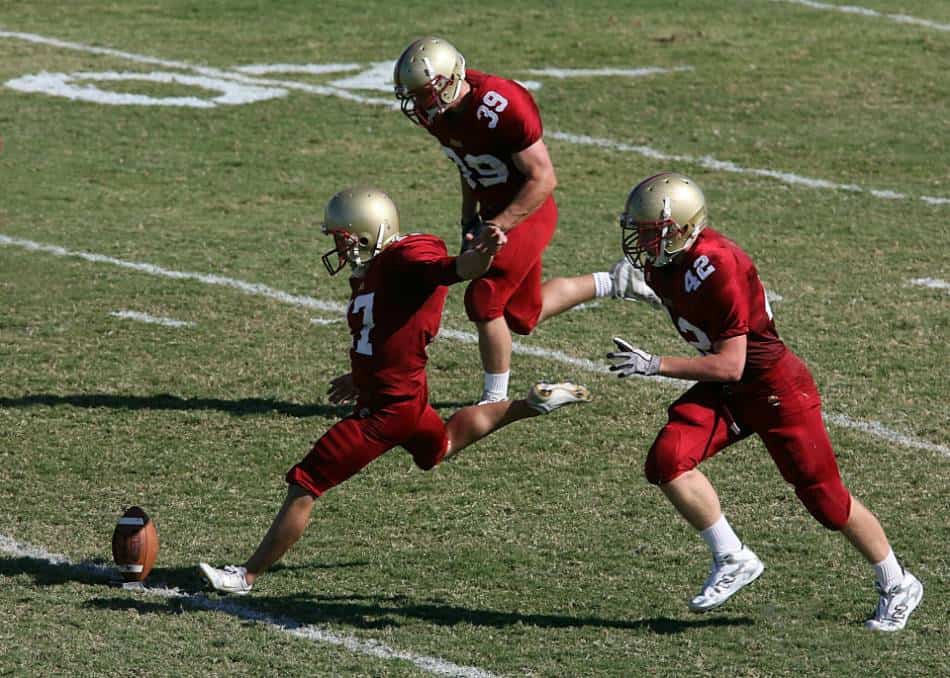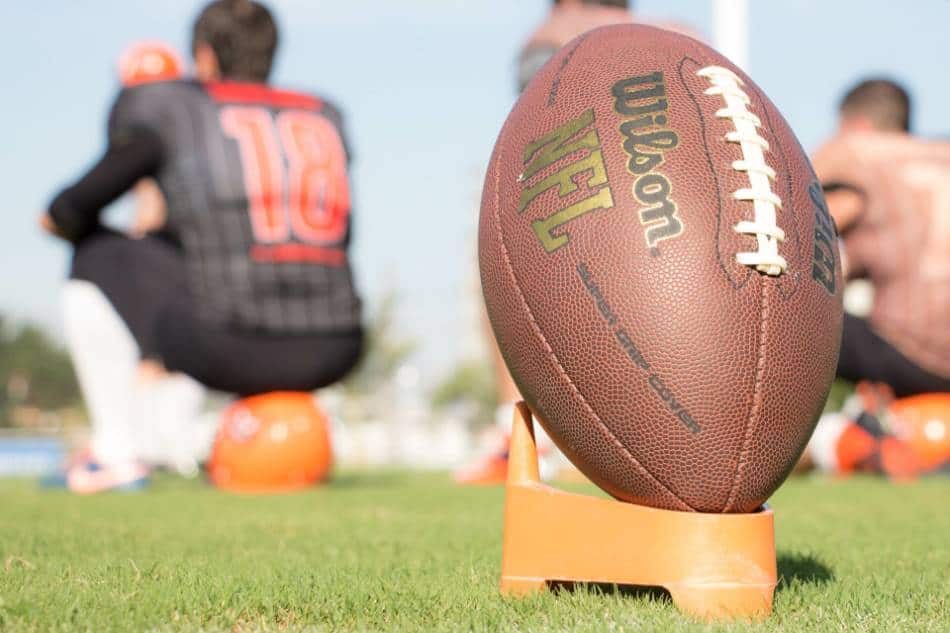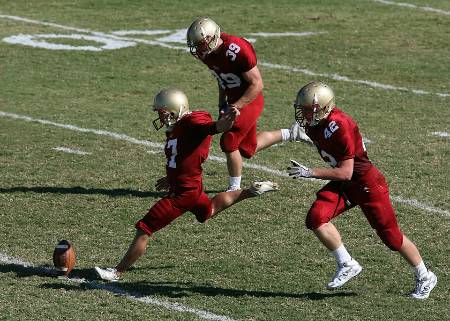
Squib kicks are one of the most unusual plays in football and they can be difficult to understand. When would a team use a squib kick, and for what purpose? But before we go into too much detail…
What is a squib kick in football?
A squib kick is a type of short, low-arcing kickoff that teams utilize to limit the potential for kick return touchdowns and to confuse the receiving team. Squib kicks are commonly used at the end of a half to run time off the clock, but they can be used effectively at any point in a game.
Squib kicks can take on a variety of forms and can be used in different situations, but they are generally used in scenarios that maximize their effectiveness. They have become a vital part of football strategy and should have a place in any coach’s playbook.
What Is the Point of a Squib Kick?
The point of a squib kick is for the ball to be kicked into a place on the field where it is difficult to be returned efficiently.
A typical kickoff has a high arc and goes a long distance, as well as directly to the opposing team’s best kick returner who is positioned near the opposing goal line. Most often, the kicking team does this in order to gain a better field position for their defense.
In contrast, squib kicks are low, line-drive kicks that are intentionally kicked into a gap in the receiving team’s formation. These kicks then hit the ground, utilizing the ball’s oblong shape to provoke unpredictable bounces. In general, these bounces are difficult for any football player to recover.
In the case of squib kicks, the ball needs to be recovered quickly by the closest players to the bounce so the receiving team can keep possession. These players are usually used to blocking and not used to handling the ball.
Why Is It Called a Squib Kick?
The squib kick is named after Mike Squib, who may have been the original creator of the intentionally short kickoff. Be sure to stick around to read more about the history of the squib kick later on in this post.
When to Kick a Squib Kick
Squib kicks are used in a variety of situations but are most commonly used at the end of the first half to run off the last few seconds before halftime. Being that squib kicks are difficult to recover, they take more time off the clock than a traditional kickoff. Additionally, the field position disadvantage that comes with a squib kick is minimized in this situation because of the lack of time for the offense to operate.
Squib kicks can be used nearly anytime throughout a game, however. The most common use of a squib kick outside of the end-of-half scenario is to confuse the return team and to either cause a fumble or a short return.
Squib kicks can also be used to limit the effect that a dangerous kick returner can have on the game. By kicking the ball short of the opposing team’s main returner, a different player may be forced to return the ball.
If the ball does end up reaching the main returner, it does so much slower than on a typical kickoff. This allows for more time for the coverage unit of the kicking team to get down the field and make a tackle, therefore limiting the potential explosiveness of a return.
However, squib kicks do have one main disadvantage that often limits their usage – the receiving teams get improved field position as a result of the shorter kick. Especially in the NFL, kicking teams seldom want to give the opposing offense great field position when there’s a lot of time left on the clock, so squib kicks are typically limited to the end of the half or the end of the game.
How to Kick a Squib Kick

When looking to execute a squib kick, it is imperative to align in the same formation as when you perform a normal kickoff. This allows for the surprise element that makes squib kicks effective.
The kicker should address and run-up to the ball in the same way as a normal kickoff as well. However, the kicker should strike his foot higher up on the ball in comparison to the typical method. By hitting the middle of the ball with his foot instead of the lower part of the ball, he can drive the ball at a lower trajectory, getting it to land in the desired area in the middle of the returning team’s formation
The rest of the players on the kick coverage team should also adjust when executing a squib kick. Instead of running straight ahead in order to get down the field as fast as they can and attack the returner, they should pay attention to the bounces of the ball and look to adjust their angles accordingly.
For instance, if the ball bounces toward the sideline, the whole coverage team should change their coverage routes in order to close off the area around the ball and keep the returning player confined to the small amount of field near the sideline. This limits the potential for a big return and a good field position for the returning team.
Can the Kicking Team Recover a Squib Kick?
With all of the wild bounces that a squib kick might take, it is certainly possible that the kicking team may reach the ball before the receiving team is able to secure it. In this case, can the kicking team recover a squib kick?
The answer is yes – in fact, the kicking team can recover the ball on any type of kickoff, including the traditional variety. However, this is much more likely to happen a squib kick due to the unpredictable nature of the bounces and the fact that less experienced players may need to attempt to handle the ball.
Can You Fair Catch a Squib Kick?
A common way to field a kickoff is with a fair catch. By waving an arm above their head, the returner has the opportunity to field a kicked ball without the danger of being tackled. However, signaling for a fair catch also gives up the returner’s ability to advance the ball.
A fair catch may seem like a safe way to field the ball when dealing with a squib kick, but they’re usually not used.
The main reason that fair catches aren’t commonly used with squib kicks is that fair catch signals are not valid on balls that hit the ground. So, if a ball bounces before reaching the return man, a fair catch simply isn’t possible or legal under the rules of the game.
However, if a squib kick does not bounce before reaching a return man (if it was kicked too high, for example), the receiver can still signal for a fair catch. This can be a smart way for those who don’t typically handle the ball to safely manage a squib kick if the opportunity arises for this type of play.
History of the Squib Kick
Squib kicks may seem like they’re as old as the game of football itself, but the truth is that they have only been around for about the last 40 years.
Like many other football innovations, the squib kick was thought up by famous head coach Bill Walsh. He credits a California high school kicker named Mike Squib for the creation of this short kickoff, which Walsh witnessed while attending one of Squib’s high school games.
While Walsh was coaching the San Francisco 49ers in the 1981 season, kicker Ray Wersching mistakenly kicked the ball into the air at an odd angle and distance due to an injury. However, the unusual kick worked to the 49ers advantage, as the ball erratically bounced in the open space between the receiving players.
Walsh took note of this odd result and also remembered Squib’s unique kickoff method. He would go on to replicate this kick in game situations, including in the 49ers’ Super Bowl win against the Cincinnati Bengals.
Famous Squib Kicks
Due to the infrequency and oddity of squib kicks, there are more than a few famous occurrences. However, within that list, there are several squib kicks that stand out from the rest of the pack.
One notable occurrence was a return by New England Patriots offensive lineman Dan Connolly in a 2010 game against the Green Bay Packers. After the Packers squibbed the kickoff to avoid dangerous returner Brandon Tate, right guard Connolly scooped up the ball, covered it with both arms, and returned it 71 yards.
The return is still the longest by an offensive lineman in NFL history and shows that you never know what could happen on a squib kick.
In terms of strategy, squib kicks have had several famous uses. For example, the Indianapolis Colts used squib kicks to avoid all-time great return man Devin Hester following Hester’s kick return touchdown to open Super Bowl XLI against the Chicago Bears. This allowed them to limit Hester’s impact on scoring and field position en route to a Super Bowl victory.
Finally, the most famous squib kick in football history occurred in the 1982 rivalry game between the University of California-Berkeley and Stanford University. Leading by one point with little time remaining on the clock, Stanford squibbed the kickoff.
Cal players picked up the ball and proceeded to execute several backward laterals, before finally running the ball through a host of Stanford defenders (and Stanford marching band members who believed the game had already ended) for a game-winning touchdown. Today, the return is simply known as “The Play”.
Squib Kick vs Onside Kick
Squib kicks and onside kicks are relatively similar, both being unusually short kickoffs. However, there are some main differences.
The main difference is that with an onside kick, the kicking team is attempting to recover the kicked ball and gain possession. In most cases, the kicking team’s main intention with a squib kick is not to recover the ball, although this may still happen on occasion.
Additionally, an onside kick is typically a shorter kick (only 10 yards or more), allowing for the kicking team to quickly reach the kicked ball and have an opportunity to recover it. Squib kicks typically travel a greater distance, somewhere between that of an onside kick and a typical kickoff.
What Is a Pooch Kick in Football?
Pooch kicks, like squib kicks, are another form of short kickoff. The main intention of a pooch kick is also to limit the big-play potential of a return, but it is done through a short, high kickoff instead of a low line drive like with a squib kick.
The pooch kick is even rarer than a squib kick. This is likely because it loses the surprise element of the squib kick and the ball is less likely to take unpredictable bounces like with a squib kick. At higher levels of football, teams generally aim for a touchback to limit the impact of returners instead of attempting the difficult pooch kick.
